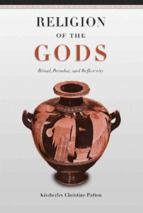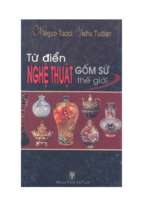Religion of the Gods
This page intentionally left blank
Religion of the Gods
Ritual, Paradox, and Reflexivity
kimberley christine patton
1
2009
3
Oxford University Press, Inc., publishes works that further
Oxford University’s objective of excellence
in research, scholarship, and education.
Oxford New York
Auckland Cape Town Dar es Salaam Hong Kong Karachi
Kuala Lumpur Madrid Melbourne Mexico City Nairobi
New Delhi Shanghai Taipei Toronto
With offices in
Argentina Austria Brazil Chile Czech Republic France Greece
Guatemala Hungary Italy Japan Poland Portugal Singapore
South Korea Switzerland Thailand Turkey Ukraine Vietnam
Copyright © 2009 by Kimberley C. Patton
Published by Oxford University Press, Inc.
198 Madison Avenue, New York, New York 10016
www.oup.com
Oxford is a registered trademark of Oxford University Press
All rights reserved. No part of this publication may be reproduced,
stored in a retrieval system, or transmitted, in any form or by any means,
electronic, mechanical, photocopying, recording, or otherwise,
without the prior permission of Oxford University Press.
Library of Congress Cataloging-in-Publication Data
Patton, Kimberley C. (Kimberley Christine), 1958–
Religion of the gods : ritual, paradox, and reflexivity / Kimberley
Christine Patton.
p. cm.
Includes bibliographical references.
ISBN 978-0-19-509106-9
1. Religion. 2. Religions. 3. Ritual. I. Title.
BL41.P38 2006
202'.11—dc22
2005018935
9 8 7 6 5 4 3 2 1
Printed in the United States of America
on acid-free paper
MOSES H. ROLFE
May 8, 1848
April 18, 1907
“He sleeps but wakes elsewhere
For God hath said Amen”
Grave epitaph
First Parish Burying Ground
Newbury, Massachusetts
1635
For Moses
Amín
This page intentionally left blank
Die Welt steht auf mit euch
Jetzt wär es Zeit, daß Götter traten aus
bewohnten Dingen . . .
Und daß sie jede Wand in meinem Haus
umschlügen. Neue Seite. Nur der Wind,
den solches Blatt im Wenden würfe, reichte hin,
die Luft wie eine Scholle umzuschaufeln:
ein neues Atemfeld. Oh Götter, Götter!
Ihr Oftgekommenen, Schläfer in den Dingen,
die heiter aufstehn, die sich an den Brunnen,
die wir vermuten, Hals und Antlitz waschen
und die ihr Ausgeruhtsein leicht hinzutun
zu dem, was voll scheint, unserm vollen Leben.
Noch einmal sei es euer Morgen, Götter.
Wir wiederholen. Ihr allein seid Ursprung.
Die Welt steht auf mit euch, und Anfang glänzt
an allen Bruchstellen unseres Mißlingens . . .
Now would be the time for Gods to step forth
From inhabited things . . .
And knock down every wall
In my house. New page. Only the wind,
Flinging such a leaf into change,
Would suffice to blow up the air like soil;
A new breathing-field. Oh Gods! Gods!
You often-come, sleepers in things,
Who resurrect gaily, who at the well
Which we imagine bathe throat and face,
And who easily add their restedness
To that which seems full, our full lives.
Once more let it be your morning, Gods.
We repeat. You alone are the primal source.
With you the world arises, and a fresh start gleams
On all the fragments of our failures . . .
—Rainer Maria Rilke
Trans. Murray Stein, with corrections by author
Ich begreife im Leben der Götter (das doch wohl im Geistigen immer wieder
sich erneut und abspielt und recht hat) nichts so sehr als den Moment, da sie
sich entziehen; was wäre ein Gott ohne die Wolke, die ihn schont, was wäre
ein abgenutzter Gott?
I grasp nothing in the life of the Gods (which in the spirit most probably ever
renews itself and runs its course and has its truth) so much as the moment in
which they withdraw themselves: what would be a God without the cloud
which preserves him? What would be a worn-out God?
—Rainer Maria Rilke, Letter to the Fürstin Marie
von Thurn und Taxis, September 23, 1911.
Trans. Murray Stein
Acknowledgments
This book has been a long time in birthing, and divine reflexivity,
“the religion of the gods,” might have been better illumined by others. Nevertheless it is my hope that this might be an dρχa. To my advisors and colleagues in ancient Greek religion, Albert Henrichs, and
in classical archaeology, David Gordon Mitten, my heartfelt thanks
for your help and heroic patience over the years. I offer special thanks
to the American School of Classical Studies at Athens, without whose
sponsorship for my work as an associate I could not have researched
this topic in 1991. A Charlotte Newcombe Fellowship and a Whiting
Fellowship allowed the initial dissertation to be written at Harvard
University. Thanks belong to Cynthia Read, executive editor in religion at Oxford University Press, who has waited far longer for this
work than any editor deserves. I want to express my great gratitude, as
well, to copyeditor Margaret Case and production editor Jessica Ryan.
Thank you, Michael Anthony Fowler, fearless research assistant.
For access to vases, I deeply appreciate the assistance and patience of the curators of classical collections in Europe and the United
States: Katerina Romiopoulou and Betty Stasinopoulou at the Athens
National Museum; Friedrich Hamdorf at the Antikensammlungen in
Munich; in Berlin, at the Staatliche Museen, Ursula Kästner at the
Pergamon Museum and Gertrude Platz at the Schloss Charlottenburg; Alain Pasquier and Martine DeNoyelle at the Louvre; Judith
Swaddling at the British Museum and Donna Kurtz at the Beazley
Archives at Oxford; and in this country, John Herrmann at the
Boston Museum of Fine Arts and Joan Mertens at the New York Metropolitan Museum of Art.
Without the work of Prof. Erika Simon at the University of
Würzburg, whose brave and provocative Opfernde Götter opened up
x
acknowledgments
the problem in classical studies of libating gods on Attic vases over fifty years
ago, and who was so gracious and encouraging to me in my efforts to rethink
her conclusions, this book could never have been written. I owe her a great
debt.
A comparative religionist must constantly call upon the wisdom of others.
I would like to express special gratitude for their generously detailed comments on the manuscript to scholars Ali Asani, William Graham, Stephanie
Jamison, Jon Levenson, Bruce Lincoln, Steven Mitchell, Sarah Morris, Anne
Monius, Margaret Miller, William Paden, Nehemia Polen, P. Oktor Skjaervo,
and Michael Witzel. For their insightful reflections on the larger theoretical
question of religious gods, thanks to scholars John Carman, Jamsheed Choksy,
Sarah Coakley, Diana Eck, Marc Hirschman, Wolfhart Heinrichs, Holland
Hendrix, Larry Lyke, Margaret Miles, Eric Mortensen, Gregory Nagy, Michael
Padgett, my sister Laurie Patton, Elizabeth Pritchard, Benjamin Ray, Ronald
Thiemann, and Irene Winter. Thanks to superbly attentive graduate readers
Tracy Thorpe, Mark Kurtz, and Elizabeth Lee-Hood.
Heartfelt gratitude at the eleventh hour goes to my research assistant,
Narelle Bouthillier, and to Professor Michael Puett, who promised me miraculous passage across the plains of Mordor.
To my husband Bruce Beck, my daughters Christina and Rosemary, my
parents Anthony and Christine Patton, my brother Geoffrey Patton and my
sister-in-law Karen Kent, my cousin Heidi Patton, and my dear friends Linda
Barnes, Robert Bosnak, Gay Schoene, Erika Schluntz, Carla Pryne, Cecily
Johnston, Alexandra Kubler-Merrill, Helen Pinsky, Rachel Fell McDermott,
Gretchen Hermes, Courtney Bickel Lamberth, and Andrew Rasanen, thank
you for your steadfast love during this odyssey home—even longer than the
original from the flames of Troy to the shores of Ithaka.
September 30, 2007
800th birthday of Jalāluddı̄n Rūmi
Contents
List of Illustrations, xiii
Introduction. The Problem of Sacrificing Gods, 3
I. Ancient Greek Gods in Ritual Performance
1. Is Libation Sacrifice?, 27
2. Iconographic Evidence, 57
3. “Terribly Strange and Paradoxical”:
Literary Evidence, 101
4. “Divine Libation”: A Century of Debate, 121
5. The Problem Defined and a Proposed Solution:
Divine Reflexivity in Ritual Representation, 161
II. The Wider Indo-European World: Polytheism
Introduction: Ritualizing Gods in Indo-European
Religious Traditions, 183
6. Zoroastrian Heresy: Zurvān’s Thousand-Year Sacrifice, 189
7. “Myself to Myself ”: The Norse Odin
and Divine Autosacrifice, 213
xii
contents
III. The Peoples of the Book: Monotheism and Divine Ritual
Introduction: The Special Interpretive Challenge
of Divine Ritual in Monotheism, 239
8. The Observant God of the Talmud, 249
9. “God and His Angels Pray for the Prophet”:
A Qur›ānic Paradigm, 283
Conclusion. “Religion of the Gods”, 307
Catalogue, 000
Notes, 317
Bibliography, 457
Index, 483
List of Illustrations
1. Chart of vase shapes. Drawing by Catherine A. Alexander,
after Gisela Richter, A Handbook of Greek Art, fig. 437,
with additions and changes.
2. Attic red-figure kalpis-hydria. A: Apollo at an altar making
a libation from a phiale, between Nike or Iris, with
oinochoe, on left; Artemis and Leto on right. The Berlin
Painter, c. 485 b.c.e. Formally Boston, Museum of Fine Arts
1978.45. Transferred September 28, 2006, to the Italian
Ministry of Culture. Photograph © 2004
Museum of Fine Arts, Boston.
3. Attic red-figure kalpis-hydria. B: Athena and Hermes.
The Berlin Painter, c. 485 b.c.e. Formally Boston, Museum
of Fine Arts 1978.45. Transferred September 28, 2006, to the
Italian Ministry of Culture. Photograph © 2004 Museum of
Fine Arts, Boston.
4. Archaic pinax. Canonical scene of animal sacrifice. Sixth
century b.c.e. Found in Saphtouli cave at Pitsá. Athens
National Museum 16464. By permission of the Athens
National Museum.
5. Attic black-figure belly-amphora. Athena Promachos with
shield and spear receives animal sacrifice at a stone altar.
A priestess brandishes branches while three men approach with a bull. Black-figure belly-amphora,
c. 540 b.c.e. Berlin, West, Antikenmuseum 1686.
Photo credit: Bildarchiv Pruessischer Kulturbesitz/
Art Resource, N.Y.
2
4
5
5
6
xiv
list of illustrations
6. Attic white-ground kylix. Apollo, seated, with tortoise-shell lyre,
extends phiale to pour a libation. Raven watches from the rim
of the tondo. Onesimos?, c. 480 B.C.E. Delphi Museum 8140.
By permission of the Delphi Museum.
7. Attic red-figure column-krater. Zeus, standing, with name
inscribed, holding phiale with cascading wine. Athena, standing,
with helmet, holds oinochoe. The Diogenes Painter, late archaic.
St. Petersburg, the State Hermitage Museum Π.1899.75.
By permission of the State Hermitage Museum, St. Petersberg.
8. Attic red-figure bell-krater. Apollo, with lyre, pours from phiale
onto omphalos decorated with fillets. Artemis and Hermes; Leto,
crowned, with phiale. Manner of the Dinos Painter, 420–400 B.C.E.
British Museum E 502. © Copyright The British Museum.
9. Attic black-figure vase fragment. Athena receives a libation
poured onto her altar, inscribed AΘENAIAΣ, “belonging to Athena.”
Late archaic. Athens National Museum Fr. 1220. By permission
of the Athens National Museum.
10. Attic red-figure amphora. Warrior in armor leaving home,
extending his phiale to his wife, who raises her veil and pours
from an oinochoe. The Kleophrades Painter, late archaic period.
Munich, Staatliche Antikensammlungen und Glyptothek 2305.
From Vulci. By permission of the Staatliche Antikensammlungen
und Glyptothek München.
11. Attic red-figure krater. Libation scene at a warrior’s departure;
Nike pours from an oinochoe as he extends a phiale. A woman
(his wife?) holds his helmet and shield. The Niobid Painter,
c. 460 B.C.E. Ferrara, Museo Archeologico Nazionale T 740.
Drawing by Catherine Alexander.
12. Attic red-figure amphora. A man and a woman make a libation
offering at a bloodstained altar, over which a boukranion is
suspended. A woman extends an oinochoe, with wine visible
as it flows into the phiale of a man who holds it over the flames.
The Phiale Painter (also known as the Boston Phiale Painter),
c. 430 B.C.E. Boston, Museum of Fine Arts 01.16. Gift of
Mrs. Henry P. Kidder. Photograph © 2004 Museum of
Fine Arts, Boston.
13. Attic red-figure kylix. Symposion of deities with phialai. I: Plouton,
on couch with phiale and Persephone. The Kodros Painter,
classical period. British Museum E82. © Copyright The
British Museum.
14. Attic red-figure kylix. Symposion of deities with phialai. A: From
left: Poseidon, on couch with trident, and Amphitrite; Zeus on
couch with phiale, and Hera (both with scepters), Ganymede.
7
8
16
29
35
35
36
38
list of illustrations
The Kodros Painter, classical period. British Museum E 82.
© Copyright The British Museum.
xv
38
15. Attic red-figure kylix. Symposion of deities with phialai. B: From
left: Ares, on couch with spear, and Aphrodite; Dionysos, on couch
with thyrsos, and Ariadne. The Kodros Painter, classical period.
British Museum E 82. © Copyright The British Museum.
39
16. Athenian terracotta phiale by the potter-painter Sotades.
Mid-fifth century B.C.E. British Museum D 8. © Copyright
The British Museum.
40
17. Stone wall relief from the palace at Nineveh. The Assyrian king,
standing before an offering-table, pours a wine libation from
a phiale over dead lions. 645–635 B.C.E. British Museum 124886.
© Copyright The British Museum.
41
18. Attic black-figure olpe. Athena with helmet, shield, and aegis,
holding two spits with her left hand, roasting the entrails of a
sacrificed animal. With her right hand, she pours a libation from
a phiale onto the fire. 480–470 B.C.E. Ferrara, Museo Nazionale
14939. From Spina, Valle Pega. Drawing by Catherine Alexander.
45
19. Attic red-figure stamnos. Dionysos, in ecstasy, tearing a hind in
half (sparagmos). The Hephaisteion Painter, 480–460 B.C.E.
British Museum E 439. © Copyright The British Museum.
46
20. Poster at Kaiser Wilhelm Cathedral, Berlin. God’s Spirit
represented as a pitcher pouring itself out onto humanity.
“Gottes Geist weckt Freude und Hoffnung” (God’s Spirit
Awakens Joy and Hope). Contemporary. Photo by author.
51
21. Attic red-figure stamnos. Libation scene on Olympus (compare
to Figs. 2 and 3). A: Iris; Apollo with lyre and tipped phiale;
Artemis with oinochoe; Zeus, with scepter and phiale.
The Berlin Painter, c. 480 B.C.E. British Museum E 444.
© Copyright The British Museum.
60
22. Attic red-figure stamnos. Libation scene on Olympus. B:
Hermes; Demeter with torches; Dionysos with kantharos
and thyrsos. The Berlin Painter, middle to late, c. 480 B.C.E.
British Museum E 444. © Copyright The British Museum.
61
23. Chryselephantine statue from Delphi. Seated Apollo,
reconstructed, holding a gold phiale. Sixth century B.C.E.
Delphi Museum. Photo by author, by permission of the
Delphi Museum.
62
24. Attic red-figure cup. Divine and mortal libations on same vase.
I: Apollo alone, sitting by altar with staff and phiale. Followers
of Makron: the Painter of London E 80, 470–460 B.C.E.
British Museum E 80. © Copyright The British Museum.
62
xvi
list of illustrations
25. Attic red-figure cup. Divine and mortal libations on same
vase. A: Mortal libation scenes: man with scepter and phiale;
interior column; woman with oinochoe; man with wreath-crown
and staff extending phiale. Followers of Makron: the Painter of
London E 80, 470–460 B.C.E. British Museum E 80.
© Copyright The British Museum.
26. Attic white-ground lekythos. Artemis running, making a libation,
accompanied by small bull, bearing flaming torch and
overflowing phiale. Manner of the Bowdoin Painter, early
classical period. Musée du Louvre CA599. LOUVRE, Dist
RMN/ © Les frères Chuzeville.
27. Attic red figure trefoil oinochoe. Apollo, crowned with laurel
and holding branch, pours libation (in added red) from large
embossed phiale onto flaming altar; Artemis with oinochoe.
Attributed to the Richmond Painter, c. 440 B.C.E. Malibu, Cal.,
the J. Paul Getty Museum Villa Collection 86.AE.236. © The
J. Paul Getty Museum.
28. One of two archaic bronze statuettes of Athena from Sparta, one
of which extends a phiale with a central boss downward. Sparta
Museum 2020. Photo by the author, by permission of the
Sparta Museum.
29. Libating archaic Athena statuette from Sparta. Sparta
Museum 2020. Drawing by Catherine Alexander.
30. Attic red-figure pelike. Zeus, with eagle-bearing thunderbolt
scepter, extends phiale to be filled by Ganymede, who pours
from an oinochoe. The Geras Painter. Late archaic period.
Musée du Louvre G224. LOUVRE, Dist RMN/ © Les frères
Chuzeville.
31. Attic red-figure pelike fragment. Zeus with phiale extended to
Iris or Nike, with caduceus, who lifts a metal oinochoe. Poseidon
with phiale extended to right. All names inscribed:
ZEYΣ ΠOΣEI∆ON (reversed); IPIΣ or NIKE (ambiguous
partial inscription). The Argos Painter, late archaic period.
Berlin, West, Antikenmuseum 2166. Photo credit: Bildarchiv
Preussischer Kulturbesitz/Art Resource, N.Y.
32. Attic red-figure krater. Underworld deities hold phialai, libations
visible in added white. Cybele and Sabazios? Dionysos and
Semele or Ariadne? Hades and Persephone? Altar; priestess;
votary playing the double-flute. Celebrant with tympanon.
The Group of Polygnotos, c. 440 B.C.E. Ferrara, Museo
Archeologico Nazionale T 128. From Valle Trebia.
Photo credit: Scala/Art Resource, N.Y.
33. Attic red-figure cup. Entry of Herakles into Olympus, welcomed
by the libations of the Olympian deities. A: top, left: Zeus and
63
63
65
66
66
67
68
69
list of illustrations
xvii
Hera, with scepter, both with phialai extended, on leopard-skin
thrones, are attended by the winged Iris (?—identified as
“Hebe” by Schefold); Poseidon and Amphitrite, also on
thrones, the latter clutching a fish, both holding out phialai;
not shown: Aphrodite (scene abraded, but arm visibly extended)
and Ares; Ariadne and Dionysos on thrones (arm of the latter
extended as if to pour). The Sosias Painter, 500 B.C.E. Berlin,
West, Antikenmuseum 2278. From Vulci. Photo credit: Bildarchiv
Preussischer Kulturbesitz/Art Resource, N.Y.
70
34. Attic red-figure cup. Entry of Herakles into Olympus, welcomed
by the libations of the Olympian deities. B: bottom, left (following
Dionysos on A): the three goddesses of the seasons, standing,
with fruited boughs; enthroned, Hestia (with head-veil) and an
unidentified goddess, both with phialai; Hermes, Apollo,
Herakles (with inscription in the vocative ZE⌼ ⌽I⌳E, “Beloved
Zeus”), and Athena. Is Hermes’s ram for sacrifice? The Sosias
Painter, 500 B.C.E. Berlin, West, Antikenmuseum 2278. From
Vulci. Photo Credit: Bildarchiv Preussischer Kulturbesitz/
Art Resource, N.Y.
70
35. Attic red-figure kantharos. Dionysos pouring from kantharos
onto altar, flanked by dancing maenads; maenad with hands
extended over altar, beneath wine and toward flames. The
Nikosthenes Painter, c. 520–510 B.C.E. From Tarquinia.
Boston, Museum of Fine Arts 00.334. Henry Lillie Pierce
Fund. Photograph © 2004 Museum of Fine Arts, Boston.
72
36. Attic red-figure kylix. Dionysos extends his kantharos over
an altar. Signed by Douris as painter, c. 480 B.C.E. From Orvieto.
Boston, Museum of Fine Arts, 00.499. Gift of Mrs. S. T. Morse.
Photograph © 2004 Museum of Fine Arts, Boston.
73
37. Attic red-figure pelike. Dionysos, tearing bleeding animal victim
(hind) at a flaming altar. Maenad dancing. Satyr playing pipes.
Earlier mannerists, undetermined, early classical period.
British Museum E 362. © Copyright The British Museum.
73
38. Attic red-figure oinochoe. Nike flying, frontal view, with
thymiaterion and phiale emptying onto altar. The Berlin Painter,
490–480 B.C.E. British Museum E 513. © Copyright The
British Museum.
75
39. Attic red-figure stamnos. A: Athena pours from an oinochoe
for Zeus and Hera, who extend their phialai. The Berlin Painter,
c. 490 B.C.E. The Metropolitan Museum of Art, Gift of Christos
G. Bastis, in honor of Dietrich von Bothmer, 1988 (1988.40).
Photograph, all rights reserved, the Metropolitan Museum of Art.
76
40. B: Libation at the departure of a warrior, made by a woman
with oinochoe and phiale. Seated elder (father?). The Berlin
xviii
41.
42.
43.
44.
45.
46.
47.
48.
list of illustrations
Painter, c. 490 B.C.E. The Metropolitan Museum of Art, Gift
of Christos G. Bastis, in honor of Dietrich von Bothmer,
1988 (1988.40). Photograph, all rights reserved, the
Metropolitan Museum of Art.
Attic red-figure pelike. Triptolemus, on his winged throne,
extending phiale. Demeter, with polos, pours from oinochoe;
wine visible. The Geras Painter, late archaic period.
Berlin, 2171. Photo credit: Bildarchiv Preussischer
Kulturbesitz/Art Resource, N.Y.
Attic red-figure hydria. Zeus, enthroned with scepter, extends a
phiale while the miniature Athena is born from his head. Hephaistos
looks on with his axe, recently swung. Painter of Tarquinia 707, c.
470–460 B.C.E. Bibliothèque Nationale de France, Cabinet des
Medailles 444. By permission of the Bibliothèque Nationale
de France.
Attic red-figure stamnos. Zeus, extending phiale to Nike who fills
it with an oinochoe; Apollo and Hera. The Providence Painter,
early classical period. Musée du Louvre G370. LOUVRE,
Dist RMN/ © Les frères Chuzeville.
Attic red-figure kalpis. A winged goddess (Nike? Iris? Eos?)
stands holding an oinochoe between Zeus and Hera, who
extend phialai. A newly discovered work by the Niobid Painter,
470–460 B.C.E. By permission of Antiquarium, Ltd.,
New York. Photo by Justin Kerr.
Attic red-figure oinochoe. Apollo and Artemis at an altar. The
Altamura Painter, c. 465 B.C.E. From Sounion? Boston, Museum
of Fine Arts 97.370. Catherine Page Perkins Fund. Photograph
© 2004 Museum of Fine Arts, Boston.
Attic red-figure bell-krater. Divine and mortal libation scenes.
A: Apollo with kithara and phiale standing between Leto on left
with phiale; Artemis with oinochoe. No altar. Inscribed: LETΩ
AΠOΛΛON APTEMIΣ. The Villa Giulia Painter, c. 460–450 B.C.E.
The Metropolitan Museum of Art, Fletcher Fund, 1924
(24.99.96). Photograph, all rights reserved, the Metropolitan
Museum of Art.
Attic red-figure bell-krater. Divine and mortal libation scenes.
B: Woman running; old man with scepter; woman with
oinochoe and phiale. The Villa Giulia Painter, c. 460–450 B.C.E.
The Metropolitan Museum of Art, Fletcher Fund, 1924
(24.99.96). Photograph, all rights reserved, the Metropolitan
Museum of Art.
Attic white-ground pyxis. Judgment of Paris. Aphrodite, holding
phiale, with Eros; Athena with helmet and spear; Hera with veil
and staff; Hermes with winged boots and caduceus; Paris; man
76
77
80
80
81
82
83
83
list of illustrations
with staff. The Penthesileia Painter, 465–460 B.C.E. From Cumae.
The Metropolitan Museum of Art, Rogers Fund, 1907
(07.286.36). Photograph, all rights reserved, the
Metropolitan Museum of Art.
xix
84
49. Attic red-figure neck-amphora. Mirror scenes of divine
and human libation. A: Dionysos offering wine from
kantharos onto altar; maenad attends with bough and
oinochoe. The Niobid Painter, c. 460 B.C.E. The
Metropolitan Museum of Art, Purchase by subscription,
1899 (99.13.2). Photograph, all rights reserved, the
Metropolitan Museum of Art.
85
50. Attic red-figure neck-amphora. Mirror scenes of divine and
human libation. B: Mortal (Beazley: “King”) in libation scene;
woman attends with bough and oinochoe. The Niobid Painter,
c. 460 B.C.E. The Metropolitan Museum of Art, Purchase by
subscription, 1899 (99.13.2). Photograph, all rights reserved,
the Metropolitan Museum of Art.
86
51. Red-figure Nolan amphora. Athena spills wine from her phiale,
whose lobes are painted with added white, onto the ground; a
female figure pours from an oinochoe. The Achilles Painter,
460–450 B.C.E. The Metropolitan Museum of Art, Rogers Fund,
1912 (12.236.1). Photograph, all rights reserved, the Metropolitan
Museum of Art.
87
52. Attic red-figure neck-amphora. Apollo with laurel wreath and
tortoise-shell lyre extends a phiale over an altar, in a sanctuary?
Artemis to left with oinochoe; Leto to right with phiale. The
Niobid Painter, c. 450 B.C.E. Würzburg, Martin von WagnerMuseum H 4533. By permission of the Martin von WagnerMuseum der Universität Würzburg. Photo K. Oehrlein.
88
53. Attic red-figure hydria. Departure of Triptolemos, on winged
chariot with overflowing phiale extended; Kore with torch;
Demeter with crown and scepter, pouring from oinochoe.
Name-inscriptions: TPIΠTOLEMOΣ DEMHTHP. The Painter
of London 183, classical period. British Museum E 183. From
Nola. © Copyright The British Museum.
90
54. Attic red-figure calyx-krater. The divine inhabitants of the
Erechtheion on the Acropolis: Athena and aging king Kekrops,
with snake tail, both with phialai, bring liquid offerings at the
birth of Erichthonios. Nike hovers above them with oinochoe.
Basket of Erichthonios stands closed, covered with a cult rug,
next to sacred olive tree of Acropolis. The Kekrops Painter, late
fifth century B.C.E. Eichenzell/Fulda, Museum Schloss Fasanerie,
Hessiche Hausstiftung, FAS AV 77. By permission of the
Museum Schloss Fasanerie.
92
- Xem thêm -




















